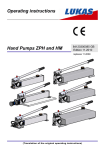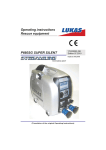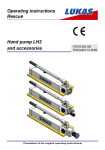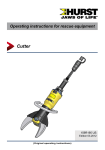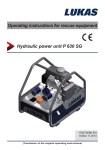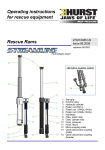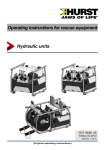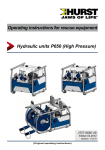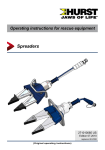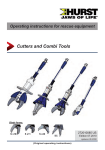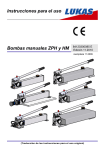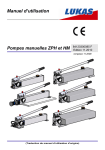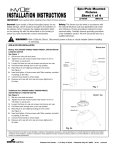Download Operating instructions Rescue equipment Mobile Selection Manifold
Transcript
Operating instructions Rescue equipment Mobile Selection Manifold MSM-2D PN500 - STREAM 1 3 5 179003085 GB Issue 03.2009 2 4 6 6 (Translation of the original operating instructions) Contents Page 1. Danger classes 3 2. Product safety 4 3. Safety rules for hydraulic hose lines 7 4. Proper use 7 5. Functions and performance capabilities 7 5.1 Description 7 5.2 Circuit diagram 8 5.3 Hydraulic supply 9 5.4 Control of the work movements 9 5.5 Connection between Mobile Selection Manifold and motor pump 9 5.6 Connection between control module and hydraulic cylinders 9 6. Connection of the devices 9 6.1 Hydraulic 9 6.2 Connecting the monocouplings 10 6.3 Connecting the quick-disconnect couplings 11 7. Operation 11 7.1 Preparatory measures 11 7.2 Operation of the Mobile Selection Manifold 12 7.3 Removal of the components 13 8. Care and maintenance 14 9. Repairs 15 9.1 General 15 9.2 Preventative service 15 9.3 Repairs 16 10. Troubleshooting 19 11. Technical data 20 21 11.1 Hydraulic fluid recommendations 11.2 Hose lines 21 11.3 Operating temperature range 21 12. EC Conformity declarations 22 13. Notes 23 2 1. Danger classes We distinguish between various categories of safety instructions. The table shown below shows you the overview, via the assignment of symbols (pictograms) and signal words, of the concrete danger and the possible consequences. Damage / injury to Key word Definition Consequences DANGER! Immediate danger Death or major injury WARNING! Potentially dangerous situation Potential death or major injury CAUTION! Less dangerous situation Minor or slight injury CAUTION! Danger of damage to device / environment Damage to the equipment, damage to the environment, damage to surrounding materials NOTE Advice for application and other important / useful information and advice No injury / damage to persons / environment / equipment device human Pictogram - Wear helmet with face guard Wear protective gloves Wear safety shoes Proper recycling Protect the environment Read and follow operating instructions 3 2. Product safety LUKAS products are developed and produced in order to ensure the best performance and quality with proper use. The safety of the operator is the most important consideration in the product design. In addition, the operating instructions are meant to help in using the LUKAS products safely. In addition to the operating instructions, all generally applicable, statutory and other binding rules for accident prevention and for environmental protection must be heeded and disseminated. The device must only be operated by educated persons who are trained in safety technology, since otherwise there is a risk of injury. We advise all users before using the device to carefully read through the operating instructions and to follow the instructions contained therein without exception. We also recommend that you get instructed by a qualified trainer in the use of the product. WARNING / CAUTION! The operating instructions for the hoses, the accessories and the connected devices must also be heeded! Even if you have already received instruction, you should read the following safety instructions again. WARNING / CAUTION! Make sure that the accessories used and the connected devices are suitable for the specified max. operating pressure! Refrain from any work procedure that detracts from the safety and/or stability of the device! Wear protective clothing, protective helmet with visor, safety shoes and protective gloves. Immediately report changes that occur (including changes in operating behaviour) to the appropriate persons/ departments! If necessary, immediately shut down and secure the device! Check the device for visible defects or damage before and after use. Check all lines, hoses and screwed connections for leaks and externally visible damages and repair immediately! Escaping hydraulic fluid can lead to injuries and fires. Working under loads is prohibited if they are raised exclusively with hydraulic devices. If this work is unavoidable, sufficient mechanical supports are additionally required. 4 In the event of malfunctions, shut down the device immediately and secure it. You should have the malfunction repaired immediately. Do not make any changes (add-ons or conversions) on the device without the approval of LUKAS. Heed all safety instructions and hazard warnings on the device and in the operating instructions. All safety instructions and hazard warnings on the device are to be kept intact and in a legible condition. Make sure that all safety covers are present on the device and in proper working condition. Safety equipment must never be disabled! Before switching on/engaging the device or while operating the device, it must be ensured that no one is endangered by the operation of the device. The maximum permissible operating pressure must not be changed. Prevent electrostatic discharge, which has the possible consequence of spark formation, when handling the device. Observe all intervals that are prescribed or specified in the operating instructions for recurring tests and/or inspections. When working in the vicinity of live components and lines, take appropriate measures for preventing current transfers or high voltage flashovers to the device. Use only original LUKAS accessories and spare parts for repairs. The device is filled with hydraulic fluid. These hydraulic fluids can be detrimental to health if they are swallowed or their vapours are inhaled. Direct contact with the skin should be avoided for the same reason. Also, when handling hydraulic fluids, note that they can negatively affect biological systems. When operating and/or storing the device, make sure that the function and the safety of the device are not impaired by strong external temperature differences or that the device is damaged. Keep in mind that the device can also heat up when it is used continuously. Make sure that you do not get caught in the hose or cable loops and trip when working with or transport the device. 5 Make sure there is adequate lighting while working. Before transporting the device, always check to see that the accessories are positioned securely to prevent the possibility of an accident. Always keep these operating instructions easily accessible at the site where the device is used. Make sure you properly dispose of all removed parts, leftover hydraulic fluid, leftover oil and packing materials. In addition to the safety instructions of these operating instructions, all generally applicable, statutory and otherwise binding national and international rules for accident prevention need to be heeded and disseminated! WAR N IN G / C A U TION / AT T E NT I O N! The device is specified exclusively for the purpose represented in the operating instructions (see Chapter "Proper use"). Any use that differs or goes beyond this is considered improper. The manufacturer/supplier shall not be held liable for damages resulting from improper use. The risk shall be borne solely by the user. Proper use also includes heeding the operating instructions and complying with the inspection and maintenance requirements. Never work in a fatigued or intoxicated state! 6 3. Safety rules for hydraulic hose lines For more information, consult the separate operating instructions for the hose lines (116500085). 4. Proper use The Mobile Selection Manifold is designed specifically to control the piston movement of LUKAS hydraulic cylinders (without independent control valve). The Mobile Selection Manifold makes it possible to sensitively control the extension and retraction movement of the hydraulic cylinders in order to raise an object at two contact points with the pistons having the same travel speed (even when the load distribution of the object to be raised varies). It is used, for example, in the event of traffic accidents, train crashes, building collapses, etc. In principle, nearly all hydraulic cylinders without an independent control valve can be driven or their piston travel speed controlled without an independent control valve. WARNING / CAUTION! All objects that are to be moved need to be secured via fixed brackets or by using substructures. In addition, it needs to be ensured that the hydraulic cylinders used cannot slip away. WARNING / CAUTION / ATTENTION! The hydraulic cylinders may not be placed against: - live cables - explosive elements such as air bag cartridges NEVER operate the Mobile Selection Manifold with a higher inlet operating pressure than in the "technical data" chapter. A higher setting may cause property damage and/or injuries. Accessories and spare parts for the device can be obtained from your authorised LUKAS dealer! 5. Functions and performance capabilities 5.1 Description The Mobile Selection Manifold controls the travel speed of the connected hydraulic cylinder via the distribution of the supplied hydraulic fluid. The Mobile Selection Manifold consists of: - a control valve (cover sheet, item 1) for defining the direction of movement of the lifting cylinders (double-acting or single-acting cylinder components) via star knob, - distribution valve (cover sheet, item 2) with hand wheel for the hydraulic fluid distribution to the connected cylinder, - pressure relief valves for the extension and retraction (firmly lodged within the device body) to protect the hydraulic system, - supply hose (cover sheet, item 4) and return hose (cover sheet, item 3) for the hydraulic fluid supply. These two hoses are connected via a monocoupling (cover sheet, item 5) or a quickdisconnect coupling pair to the hydraulic unit, - Ports A1 and B1 or A2 and B2 are connected to the hydraulic cylinders via a quickdisconnect coupling pair (cover sheet, item 6). 7 5.2 Circuit diagram Cylinder 2 Cylinder 1 Charge retaining valve B1 A1 B2 A2 Charge retaining valve Distribution valve Pressure relief valve Pressure relief valve 50 MPa 30 MPa Control valve 30+5 MPa open air spraying 8 5.3 Hydraulic supply The hydraulic supply must be provided via a LUKAS hydraulic unit. NOTE: You should always contact LUKAS or an authorised dealer before using pumps of other producers. 5.4 Control of the work movements The direction of the piston movement is determined via the control valve (cover sheet, item 1). This is controlled via the distribution valve (cover sheet, item 2). 5.5 Connection between Mobile Selection Manifold and motor The Mobile Selection Manifold and pump unit are connected via hose lines. There are already two short hose lines with a monocoupling connection or a quick-disconnect coupling pair on the Mobile Selection Manifold. If the length of hose lines is not sufficient for connecting to the pump units, then the connection can be extended by using LUKAS hose pump The Mobile Selection Manifold and hydraulic cylinders are connected via hose lines. They are not included within the scope of delivery of the Mobile Selection Manifold! The hose lines are connected exclusively via quick-disconnect couplings. 6.1 Hydraulic 6. Connection of the devices Two short hose lines with a monocoupling or a quick-disconnect coupling pair are provided on the device side; they are connected to the pump unit via a hose pair. Two quick-disconnect male couplings and two quick-disconnect female couplings are provided for the connection to the hydraulic cylinders. They are connected to hydraulic cylinders via hoses / hose pairs. Each is equipped, respectively, with quick-disconnect male coupling A1 and quick-disconnect female coupling B1 and quick-disconnect male coupling A2 and quick-disconnect female coupling B2. All hose lines are colour-coded in order to ensure a distinction between supply and return line. In connection with the couplings installed on the added hose lines and on the hose line extensions (accessories), a non-reversible connection to the device is ensured. NOTE: When controlling single-acting cylinders, the connection to ports B1 and B2 is omitted. 9 WARNING / CAUTION / ATTENTION! Make sure that the connected devices and the connected accessories are suitable for the max. operating pressure! Please consult the "Technical data" chapter to find the maximum operating pressure between hydraulic unit and Mobile Selection Manifold and the maximum operating pressure between Mobile Selection Manifold and hydraulic cylinder. 6.2 Connecting the monocouplings The device is connected via mono coupling halves (female and male) to the hydraulic pump in such a way that they cannot be reversed. Dust caps Male coupling Female coupling Before coupling, remove dust caps, then connect male and female couplings and turn locking sleeve of the female coupling in direction "1" until the locking sleeve latches. The connection is then made and secured. Decouple by turning the locking sleeve in direction "0". The coupling of the devices under pressure is also possible, assuming the connected equipment is not turned on. The supplied dust caps must be reattached to protect against infiltration of dust. NOTE: We recommend, when ambient temperatures are low and extension hoses / hose winders are used, connecting the coupling halves in a depressurised state because decoupling may otherwise require a very large exertion of force. WARNING / CAUTION / ATTENTION! The monocouplings must not be unscrewed and/or the hose lines reversed! 10 6.3 Connecting the quick-disconnect couplings The hydraulic cylinders and the hydraulic unit are connected to the Mobile Selection Manifold via quick-disconnect halves (female and male) in such a way that they cannot be mistakenly reversed. X Y Before connecting the couplings, remove the dust cap, then pull back and hold the locking sleeve of the female coupling (Position X). Push the male and female couplings together and release the locking sleeve. Finally, turn the locking sleeve into Position Y. The connection is then made and secured. Decoupling is done in the reverse sequence. NOTE: Making the coupling connection is only possible if the hoses are depressurised. The supplied dust caps must be reattached to protect against infiltration of dust. WARNING / CAUTION / ATTENTION! The quick-disconnect couplings have special functions, in part, and therefore must not be unscrewed and/or reversed! NOTE: When controlling single-acting cylinders, omit the connection to the quickdisconnect female couplings. 7. Operation 7.1 Preparatory measures WARNING / CAUTION! Before the system components are installed, the vehicle to be raised / the load to be raised needs to be properly secured against rolling and slipping away according to the respective applicable national / international guidelines and regulations! 11 7.1.1 Installing system components Procedure: 1. First, set up the hydraulic unit in a suitable location, i.e. on a flat surface at a safe distance from the load to be lifted. 2. Then, set up the hydraulic cylinders that are to raise the load. ATTENTION! During the installation, make sure that: - the base is anti-slip and level (if necessary, use a suitable base pad). - the cylinders are never used without piston guard plates. - the cylinders are stable (if necessary, use base plates or similar items). - a pressure-tight, anti-slip base pad is always used between piston guard plate and load lifting point. 3. Install the Mobile Selection Manifold at a safe distance from the load to be raised. 4. Connect the hydraulic cylinder to the Mobile Selection Manifold as described in the "Connecting the equipment" chapter. NOTE: When using double-acting hydraulic cylinders, always first connect lines B1, B2 and return line to the pump! 5. Connect the hydraulic unit to the Mobile Selection Manifold as described in the "Connecting the equipment" chapter. 7.1.2 Preparing for operation Procedure: 1. Check the fluid levels of the hydraulic unit 2. Make the hydraulic unit operationally ready. (see separate operating instructions of the hydraulic unit) 3. Start the hydraulic unit 7.2 Operation of the Mobile Selection Manifold 7.2.1 Control valve (cover sheet, item 1) The movement of the lift cylinder is determined with the control valve. Extend piston ( ): Turn star grip in the clockwise direction (in the direction of the corresponding symbol) and hold it in this position. Retract piston ( ): Turn star grip in the anti-clockwise direction (in the direction of the corresponding symbol) and hold it in this position. “Dead man” circuit: After it is released, the star grip automatically returns to the central position with complete assurance of holding the charge. 12 7.2.2 Distribution valve (cover sheet, item 2) The movement is controlled with the distribution valve. Turning the hand wheel controls which port is supplied with more hydraulic fluid. The fluid supply of the other port can be throttled down to almost 0. The extension and retraction speed of the hydraulic cylinders is indirectly affected by controlling the fluid quantity. increased supply of the cylinder at the connection A2 - B2 Central position, i.e. both cylinders are supplied evenly with hydraulic fluid. increased supply of the cylinder at the connection A1 - B1 7.2.3 Pressure relief valve The pressure relief valves are adjusted to a set pressure and secured. WARNING / CAUTION / ATTENTION! The pressures set on the pressure relief valves may not be changed without the direct permission of LUKAS! NOTE: The system pressure that is generated between the Mobile Selection Manifold and hydraulic cylinders is not identical to the system pressure between the Mobile Selection Manifold and hydraulic unit! (Consult the "Technical Data" data 7.3 Removal of the components The components are removed in reverse order from the installation. ATTENTION! Before the final removal of the system components, it is absolutely essential to ensure: - that the load is located in a stable, immovable position. - all hydraulic cylinders are retracted to approx. 10 mm (0.39 in.). - the hydraulic unit is stopped. - the hose lines to the hydraulic cylinders are depressurised. 13 8. Care and maintenance A visual inspection needs to be performed after each use, but at least once every year. Every 3 years, or if there is a doubt about the safety or reliability, a functional check should be also performed (In so doing, also heed the corresponding applicable national and international specifications related to the maintenance intervals of rescue devices). In the Federal Republic of Germany, regular safety technology tests are prescribed in accordance with the regulations of Statutory Accident Insurance (GUV). ATTENTION! Clean off any dirt before controlling the equipment! WARNING / CAUTION / ATTENTION! To perform maintenance and repairs, personal safety equipment appropriate for the work is an absolute requirement. Tests to be performed: Visual inspection Mobile Selection Manifold • Mobile Selection Manifold without damage and deformation, • General leak-proofness (leakages), • The freedom of movement of the control valve and the distribution valve, • All screw connections tightened, • Identification plate and direction symbols legible, • Couplings easy to connect, • Dust caps in place. • All protective covers in place and undamaged. Hoses • Visual inspection for obvious damage, • Check for leaks. Functional check (only when operation of the complete system is possible) • Cylinder easy to retract, • No additional movement of the cylinder when the control valve is released during the process (dead man circuit), • Control of the travel speed can be affected evenly and continuously, • No suspicious noises. NOTE: Before the functional check of the Mobile Selection Manifold, check the additional system components (cylinder, hydraulic unit, etc.) for correct operation. 14 9.1 General 9. Repairs Service work may only be performed by the device manufacturer or by personnel trained by the device manufacturer and authorised LUKAS dealers. For all components, only original LUKAS replacement parts may be supplied in exchange, as are listed in the spare parts list, because in this way also any required special tools, assembly instructions, safety aspects, tests absolutely must be taken into consideration (see also the chapter "Care and maintenance" for more information). During the assembly work, pay particular attention to the cleanliness of all components because dirt can damage the rescue equipment! WARNING / CAUTION / ATTENTION! Wear protective clothing when making repairs because the devices may be under pressure even in the idle state. NOTE: Always mail the warranty registration card back to LUKAS Hydraulik GmbH. Only in this way will you have a claim to the extended warranty coverage. NOTE: You should always contact LUKAS or an authorised dealer before using externally supplied couplings. ATTENTION! Because LUKAS rescue equipment is designed for the highest performance, only components may be replaced that are listed in the spare parts lists of the corresponding device. Additional components of the equipment may only be replaced if: - You have participated in a corresponding LUKAS service training course. - You have the express permission of LUKAS Customer Service (by request, check on the grant of permission. A check is necessary in each individual case). 9.2 Preventative service 9.2.1Care instructions The exterior of the device needs to be cleaned from time to time and the metallic surfaces need to be rubbed with oil to protect against corrosion. 9.2.2Functional check If there are doubts about safety or reliability, a functional check also needs to be performed. 15 9.3 Repairs 9.3.1Replace or tighten hoses Hose connection of the pressure and/or return line leaky or hoses defective. Tighten the hose connections on the Mobile Selection Manifold. (Attention! Observe tightening torque MA = 40 Nm!) NOTE when monocouplings are used: In order to change the hoses, the connected monocouplings must first be removed. ATTENTION (with monocoupling system)! Make sure that the "T" joint of the Mobile Selection Manifold is always connected to the "T" joint of the monocoupling! ATTENTION (with quick-disconnect coupling system)! The return hose on the hose line extensions (accessories) must always be equipped with a quick-disconnect male coupling. The supply hose line should instead be equipped with a quick-disconnect female coupling. 9.3.2 Monocouplings The monocouplings must be replaced if: - exterior damage is present, - the lock does not function, - in the coupled and/or decoupled state, hydraulic fluid continuously escapes. WARNING / CAUTION / ATTENTION! Couplings must not be repaired; they must be replaced with original LUKAS parts! During installation, tighten the coupling nuts of the hose line with a torque of MA = 40 Nm. Procedure: 1. Pull back cover from the couplings. 16 2. Loosen coupling nuts of the hose lines and remove coupling. 3. Set new coupling in place and tighten coupling nuts of the hose lines with a torque of MA = 40 Nm and slide the cover of the couplings back on. ATTENTION! Make sure that the "T" joint of the Mobile Selection Manifold is always connected to the "T" joint of the monocoupling! 9.3.3 Quick-disconnect couplings The quick-disconnect couplings should be replaced if: - exterior damage is present, - the lock does not function, - in the coupled and/or decoupled state, hydraulic fluid continuously escapes. WARNING / CAUTION / ATTENTION! Couplings must not be repaired; they must be replaced with original LUKAS parts! During installation in the valve block, tighten the coupling with a torque of MA = 40 Nm. Procedure: 1. Unscrew coupling from the Mobile Selection Manifold. 2. Fit new coupling and screw on with a torque of MA = 40 Nm. ATTENTION! The couplings need to be installed as illustrated on the cover sheet! 17 ATTENTION! The return hose on the hose line extensions (accessories) must always be equipped with a quick-disconnect male coupling. The supply hose line should instead be equipped with a quick-disconnect female coupling. 9.3.4 Decals All damaged and/or illegible decals (safety instructions, name plates, etc.) must be replaced. Procedure: 1. Remove damaged and/or illegible decals. 2. Clean surfaces with acetone or industrial alcohol. 3. Adhere new decals. Make sure to adhere the decals in the correct positions. If this is no longer known, you should consult your authorised LUKAS dealer or contact LUKAS directly. 18 10. Troubleshooting Trouble Check Cause Solution Piston of the Hose lines hydraulic cylinder is properly moving slowly or with connected? jerks Pump unit running? Air in the hydraulic system Venting pump system System pressure Pump pumping (high pressure) is not smoothly? Hose reached: lines connected? Adjustment pressure on the “pressure relief valve for extension” too low due to setting behaviour. Have the adjustment performed by an authorised dealer or directly by LUKAS. Cylinder pistons extend, but do not retract Pump pumping smoothly? Cylinder pistons extending? Hose lines properly connected? Adjustment pressure on the “pressure relief valve for retraction” too low. Charge retaining valve blocked Pistons of the cylinders do not extend or retract Hose lines properly connected? Control valve in home position (depressurised circulation) Have the adjustment performed by an authorised dealer or directly by LUKAS. Repair by authorised dealers or by LUKAS directly! Turn the star grip of the control valve into the desired direction of travel. The piston of a cylinder is not extending or retracting In the case of a monocoupling system: Hose lines cannot be connected In the case of a monocoupling system: Hose lines frequently cannot be connected or are difficult to connect Hose lines properly connected? Control valve defective Repair by authorised dealers or by LUKAS directly! Distribution valve not set to the corresponding cylinder Turn distribution valve to control the corresponding cylinder. Coupling defective Coupling should be replaced immediately Check the Hydraulic fluid viscosity and the not suited to the use temperature of application the hydraulic fluid used. Coupling defective 19 Hydraulic fluid needs to be changed (see the chapter “Hydraulic fluid recommendation” for more information) Coupling should be replaced immediately In the case of a Is the pump quick-disconnect running? coupling system: Hose lines cannot be connected They are under pressure Relieve pump pressure Coupling defective Coupling should be replaced immediately Hydraulic fluid escaping from the hoses or at the joints Leakage, possible damage Replace hoses Mechanical damage or contact with aggressive media Replace hoses Coupling defective Coupling should be replaced immediately Are the hose lines defective? Damage on the surface of the hydraulic hoses Leakage at the couplings Coupling damaged? If the defects cannot be remedied, notify an authorised LUKAS dealer or contact LUKAS Customer Service directly! The address of LUKAS customer service is: LUKAS Hydraulik GmbH Weinstraße 39, Postfach 2560, D-91058 Erlangen D-91013 Erlangen Phone:(+49) 09131 / 698 - 348 Fax.: (+49) 09131 / 698 - 353 11. Technical data Because all values are subject to tolerances, there may be small differences between the data of your device and the data of the following tables! Type Ref. No. MSM-2D PN500-STREAM 119006000 179006000 330 x 180 x 270 12.99 x 7.09 x 10.63 Dimensions lxwxh [mm] [in.] Weight (including hydraulic fluid filling) [kg] 5,8 6,0 [lbs.] 12.8 13.2 max. operating pressure (pump - mobile selection manifold) [MPa]* 70 [psi.] 10,153 max. operating pressure [MPa]* (mobile selection manifold [psi.] cylinder) Coupling system (to the unit) 50 7,252 quick-disconnect coupling 20 monocoupling * 1 MPa = 10 bar 11.1 Hydraulic fluid recommendations Mineral oil DIN ISO 6743-4 for LUKAS hydraulic equipment and others Oil temperature range -20 .... +55°C Oil code HM 10 Viscosity rating VG 10 Remarks A Oil code HM 10 Viscosity rating VG 10 Remarks A Oil temperature range -4.0 .... +131°F recommended viscosity range: 10...200 mm²/s Supplied with HM 10 DIN ISO 6743-4. (10…200 cSt.) ATTENTION! Before using hydraulic fluids that do not correspond to the aforementioned specifications and / or are not purchased from LUKAS, you must contact LUKAS! 11.2 Hose lines Bending radius Rmin = 38 mm (Rmin = 1.5 in.) Pressure resistance Safety factor: Burst pressure / max. Operating pressure, min. 4:1 Temperature resistance - 40°C ... + 100°C (- 40°F … + 212°F) Operating fluid Mineral oil according to DIN EN ISO 6743-4 11.3 Operating temperature range Operating temperature:-20 °C -4 °F ... +71 °C ... +160 °F 21 12. EC Conformity declarations 22 13. Notes 23 Please properly dispose of all packing materials and removed parts. LUKAS Hydraulik GmbH Phone:(+49) 0 91 31 / 698 - 0 Fax.: (+49) 0 91 31 / 698 - 394 e-mail: [email protected] Made in GERMANY MSM_2D_STREAM_BA_GB_179003085_0309.indd © Copyright 2009 LUKAS Hydraulik GmbH Subject to modifications Weinstraße 39, D-91058 Erlangen Postfach 2560, D-91013 Erlangen
























